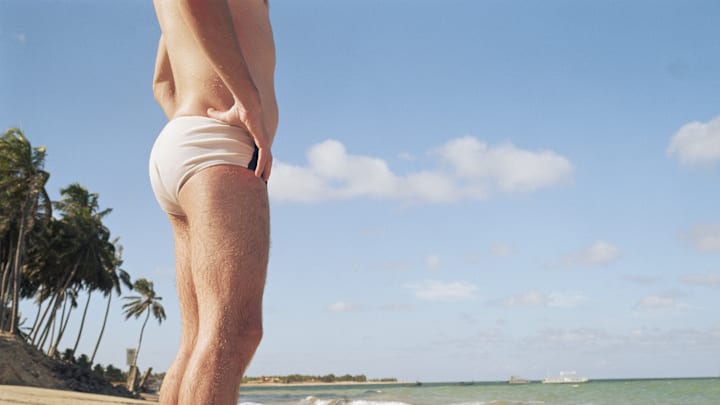The men strutting along Bondi Beach near Sydney, Australia, in 1961 provoked gasps. The typical crowd of conservative beachgoers normally showed little skin while in their bathing suits; men often draped a beach skirt over their trunks, and women were reluctant to bare even too much shoulder. But these new sunbathers were sporting only a spare, shrink-wrapped bottom that hugged their hips instead of their waist.
The men were wearing Speedos. A beach inspector called the police, and the men were promptly arrested for indecent exposure.
A magistrate declined to pursue the matter, citing the fact that the men weren’t guilty of public nudity because no pubic hair was showing. But the ensuing publicity did wonders for the Speedo brand. The company had been around for decades at that point, but now it was set to become as synonymous with tight-fitting swim trunks as Kleenex is with tissues. Sometimes referred to as “budgie smugglers,” the Speedo would soon spread across the globe.
A Tight Fit

Speedo started with socks. After emigrating to Sydney, Australia, Scotsman Alexander McRae set up a company named McRae Hosiery in 1914 and began manufacturing socks for a needy Australian Army during World War I. Once that demand began to dwindle, McRae shifted his attention to beachwear to support a growing interest in sand and surf activity.
He renamed the company McRae Knitting Mills and took a bold step: Rather than produce the wool bathing suits common in the era, he opted to use cotton and silk. He also dismissed sleeves (at that point a swimwear staple) and instead opted for a then-controversial look that showed more skin. The resulting suit, the Racerback, fit more like a tanktop; it was a hit, particularly with competitive swimmers, when it debuted in 1928. That same year, the company adopted the name Speedo after an ad slogan—“Speed On in Your Speedo”—proved successful.
Because it had less drag than wool, Speedo swimwear quickly caught on among athletes. Champion swimmer Arne Borg became a spokesperson; Olympic swimmers adopted Speedo in the 1930s, though Australian athlete Clare Dennis was nearly disqualified in the 1932 Los Angeles Games for wearing the shoulder-baring suit. (She wound up winning the gold medal in the 200-meter breaststroke.) The scolding continued in 1936, when the Australian men’s Olympic team went bare-chested.
Another war forced McRae to pivot from making bathing suits to producing wartime goods, but after 1945, Speedo redoubled its efforts to advance swimwear both for athletes and casual beach enthusiasts who wanted to tan more of their bodies. The rise of the bikini bolstered the company; it enjoyed further success at the Olympics, where the 1956 Australian men’s team took eight gold medals. All of it helped fuel a desire for beachwear that far outpaced conservative thinking.
When Speedo started expanding to the United States and England in 1959, demand for new product increased. Enter Peter Travis, a designer who was hired by Speedo that year and tasked with coming up with a new swimwear design. His supervisors wanted Travis to mimic the popular Hawaiian board short; Travis wanted to do something more daring.
“My reply was, ‘The whole world will have that. I will start with a costume you will swim in,” Travis told The Sydney Morning Herald in 2008.
Travis cut a swim short to sit around the hips instead of the waist, which he thought would be more stable. He also trimmed around the thigh to allow for greater freedom of movement. The new Speedo product came in three different sizes: 7 inches, 5 inches, or 3 inches. The larger the size, the more of the hip it would cover.
That’s when trouble began brewing at Bondi Beach. At the time, Australia had strict policies about swimwear: A local government ordinance mandated that both men’s and women’s suits cover the body from armpits to waist and extend over the legs by 3 inches. One pundit wrote in to The Daily Telegraph to muse, “When will women realize there is nothing very attractive about the female navel?”
Since this was a radical change for swimwear, men initially went for the more modest size of 7 inches. But as time went on, sales of the smallest size grew larger. By their third year on the market, the 3-inch version was the most popular.
Sports and Speedo

The increased provocation might have been why some people embraced Speedo, but others simply found the design practical. At the 1968 Olympics in Mexico City, 27 out of 29 gold medal winners were sporting the gear. At the 1972 Munich Olympics, 21 out of 22 world records were broken by Speedo-wearers. The company steadily reduced the amount of drag on swimsuits, with the majority of competitors preferring it over any other manufacturer.
As time went on, Speedo continued to innovate, eventually developing a suit that seemed to work a little too well. In 2008, the company’s LZR suits, which essentially squeezed swimmers into a streamlined tube, were banned by swimming governing body FINA. (Michael Phelps set records in seven of his eight events at the 2008 Beijing Olympics in an LZR.) Speedo then developed the Fastskin 3 system, compromised of a suit, goggles, and cap that had a more harmonious custom fit for athletes. The Fastskin series was approved by FINA and continues to be a common sight at the Olympics.
The history of Speedo, a brand that has become crucial to athletes, was nearly in danger of disappearing in 2012, when conservators at The Powerhouse Museum in Sydney noticed some of the Speedo items in their archives were oozing. It turned out that an ester-based polyurethane used in the suits in the 1980s and early 1990s was beginning to break down when exposed to humidity. The problem was corrected by storing them in a low-humidity setting. Speedo's legacy, unlike modesty, seems like it will endure.
A version of this story ran in 2021; it has been updated for 2023.
